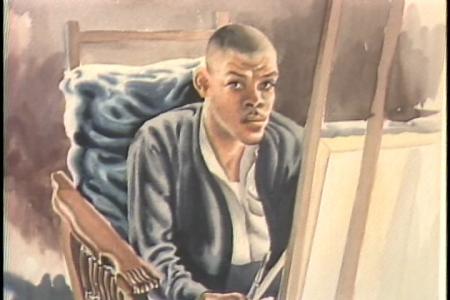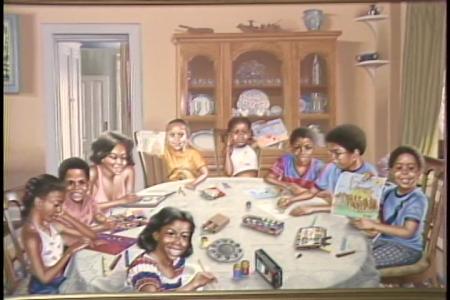I cannot, I feel, have any regrets about my accomplishments. What comes from art will just come. I don’t feel any need to strive. - John N. Robinson
One of my favorite parts of working in an archive is the opportunity to immerse myself in other people’s worlds, to learn more about their stories and experiences. One such person I encountered recently was John N. Robinson, a native Washingtonian and dedicated artist. Featured in Volume II, Edition 2 of the Here at the Smithsonian production series, Robinson’s artwork documents not only the regional history of Washington, D.C.'s Anacostia neighborhood’s growth and development, but also the personal history of his family, often featuring his wife, children, and grandparents. The episode features Robinson interacting with a group of fifth graders at the Anacostia Community Museum.
As I watched the video footage, I was struck by his dignity and gentle character, which is also conveyed to the viewer through his art. His style is one of celebration, encouraging the viewer to reflect on the beauty found in little things.
Born on February 18, 1912 in the Holy Hill community of Georgetown, Robinson was raised by his grandparents following his mother’s death when he was only eight years old, his father having abandoned him and his four siblings not long after. Their grandmother, Anna Barton, took in laundry to help support the family. Robinson and his siblings would assist her by delivering the clothes around Georgetown. Robinson remembered his grandmother as a “warm, lovely person.” Her husband, Ignatius Barton, was a U.S. Army veteran and had been a Buffalo Soldier in the Spanish-American war. Robinson described him as a kind man with a gruff exterior.

Robinson enjoyed doodling and sketching in his spare time - and sometimes while on the job. He had to leave junior high school to begin working, due to the family’s financial situation. His grandfather arranged a job for him, dusting automobiles at the garage where Barton was employed. It was while at this job that a chauffeur noticed Robinson’s sketches on a discarded time card and showed them to his sister, Elizabeth Thompson. She brought them to the attention of James Herring, art professor and founder of the Howard University art department. Recognizing Robinson’s talent, Herring arranged for Robinson to receive art instruction at Howard for a time, free of charge. Robinson studied under the tutelage of James Porter, though he wasn’t able to stay long-term, due to financial hardship.
When he was seventeen, Robinson’s grandparents moved to the Anacostia neighborhood of Garfield Park. His new next door neighbor was Gladys Washington, with whom he fell in love; they married in 1934. Together, they had seven children, six of whom lived to adulthood. It was also after moving to Garfield Park that Robinson began to devote more time to painting, including religious murals in community churches. Robinson went on to be employed in food service at St. Elizabeth’s Hospital, eventually rising to management. He retired in 1970.
Outside of his family and community, Robinson didn’t gain much notoriety as an artist until later in life. In the 1940s, he displayed his work at Lafayette and Franklin Parks, through the Outdoor Art Fairs sponsored by the Times Herald. Later his work was featured at the Barnett-Aden Gallery, a haven for multicultural diversity and one of the first black-owned art galleries in America. He exhibited a one-man show at the Corcoran Gallery of Art in 1976, at a time when few blacks were welcomed there, through a partnership with the Anacostia Community Museum. Another one-man show followed at the Anacostia Community Museum in 1983. Other exhibitions included ones at Howard University, the National Museum of Natural History, St. Elizabeth’s Hospital, Atlanta University, Xavier University, Emmanuel Baptist Church, Oxon Hill Public Library, and the Washington Project for the Arts.
On October 17, 1994, John Robinson passed away. A family man, he mused that perhaps he could have been more ambitious in promoting his art earlier in life, but he also recognized success is not just in material things, but sometimes is seen best in “the happiness of those we love.”

Direct quotes were taken from exhibition catalog - John Robinson: A Retrospective, 1976, Corcoran Gallery of Art and is available at the Anacostia Community Museum Library.
Related Collections
- Accession 00-132 - Office of Telecommunications, Productions, 1982-1989, Smithsonian Institution Archives.
- “Here, Look at Mine!” exhibition records, Anacostia Community Museum Archives
- John N. Robinson artist file, Smithsonian Libraries
Produced by the Smithsonian Institution Archives. For copyright questions, please see the Terms of Use.

Leave a Comment